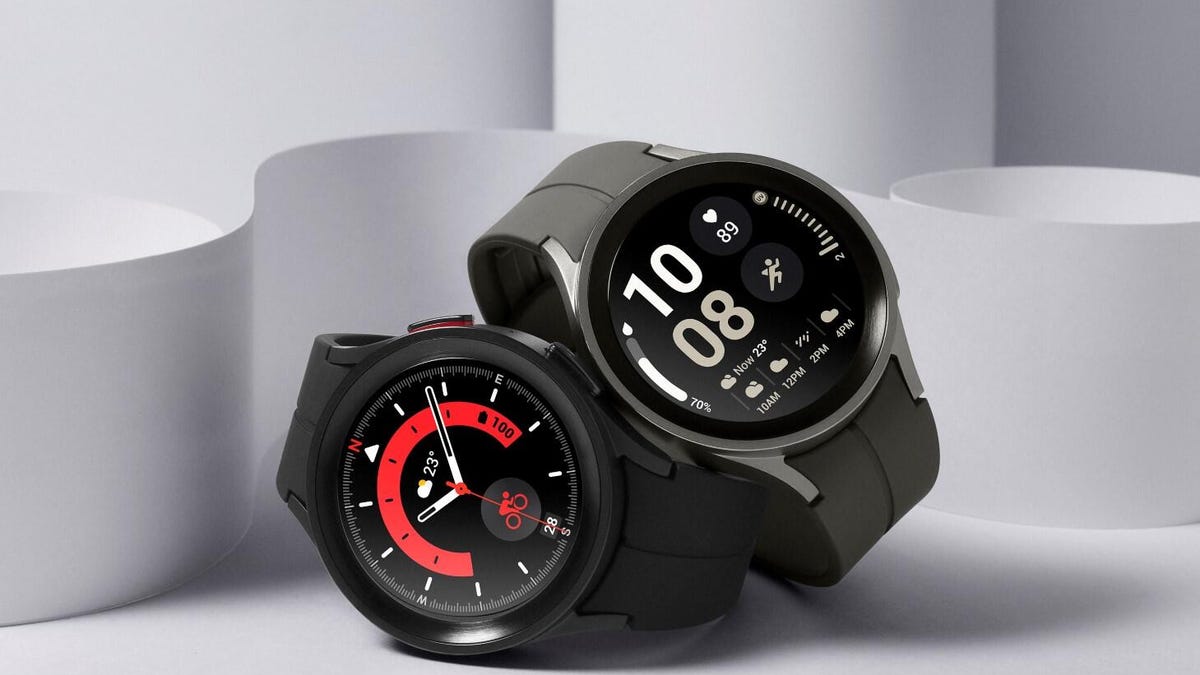Samsung has been making smartwatches for more than nine years and it has found its sweet spot between in-house hardware and Google’s Wear OS platform.
Two watch options, the Galaxy Watch 5 and Galaxy Watch 5 Pro, were announced during Samsung’s annual Unpacked event. The Galaxy Watch 5 is built for the masses and has no rotating bezel, while the Watch 5 Pro is designed and built for outdoor enthusiasts with the largest battery ever in a Galaxy smartwatch. For those who are saddened by the absence of the physical rotating bezel, Samsung says it will continue to offer the Watch 4 Classic.
More: How Samsung leapfrogged the Apple Watch, with a little help from Google
Samsung Galaxy Watch 5 Pro
As someone who’s always wearing at least one smartwatch and tracks all of my running, cycling, hiking, fishing, and other outdoor activities, I am very excited to test the Galaxy Watch 5 Pro. The new watch has a 45.4mm diameter, with a massive 590mAh battery. The latter surpasses any capacity that we’ve seen from a Samsung Galaxy Watch and is 60% larger than that of the Galaxy Watch 4.
The Samsung Galaxy Watch 5 Pro does away with the rotating bezel. June Wan/ZDNET
Watch 5 Pro also incorporates premium materials like sapphire crystal with a titanium case to keep it from wearing and tearing. A D-buckle sport band is included and is designed to offer rugged durability and a sleek fit.
For turn-by-turn hiking and biking directions, Samsung is will allow users to import GPX formatted routes into the Samsung Health app. As with previous generations, the Health app is quintessential to the functionality and data tracking of the watch. There’s also now a trackback feature to help get you navigate back to your starting point during hikes and walks. It’s a nifty feature that every sporty smartwatch should have.
The Watch 5 Pro is available in Black Titanium and Gray Titanium and starts at $449.99 for the Bluetooth model and $499.99 for the LTE model.
Samsung Galaxy Watch 5
The Galaxy Watch 5 sees a slight redesign from its direct predecessor, the Galaxy Watch 4. One change, in particular, is the new contact area, which has a wider surface area for more accurate reads and includes a temperature sensor to offer improved health and wellness metrics.
The Galaxy Watch 5 in Bora Purple, Pink Gold, and Graphite. Image: Samsung
Samsung says the Watch 5 is made of Armor Aluminum material with a sapphire crystal glass display. Powering the watch is Samsung’s Exynos W920 processor, with 1.5GB of RAM and 16GB of internal storage for music and other data. The smaller 40mm model has a 284mAh battery and the larger 44mm model has a 410mAh battery. Those numbers are fair for the simplified use cases of the non-Pro smartwatches. To charge, you can do wireless charging via the puck cable or via Wireless Powershare on a Samsung smartphone.
The smaller 40mm Galaxy Watch 5 is available in Graphite, Pink Gold, and Silver, while the larger 44mm model is available in Graphite, Sapphire, and Silver. Pricing for the Galaxy Watch 5 starts at $279.99 for the Bluetooth model and $329.99 for the LTE version.
Best of both worlds
As far as similarities go, both Galaxy Watch 5 models offer 5 ATM, IP68, and MIL-STD-810H durability, with sapphire crystal glass displays. That’s as durable as mainstream smartwatches come, and I can’t complain. The BioActive sensor sets the Galaxy Watch 5 Series apart from other smartwatches and continues to provide extensive health and wellness measurements like Optical Heart Rate, Electrical Heart Signal, and Bioelectrical Impedance Analysis. ECG is another commonality across the models and will allow users to better understand their heart health.
Bluetooth, WiFi, NFC, GPS/Glonass/Beidou/Galileo, and LTE connectivity also come provided. Wear OS powered by Samsung is the operating system, with OneUI Watch 4.5 layered atop. That means you get the best of Samsung’s former Tizen platform alongside Google’s host of smartwatch-tailored applications. Unsurprisingly, the new Galaxy Watches only work with Android smartphones — with the most optimal experience being ones made by Samsung.
